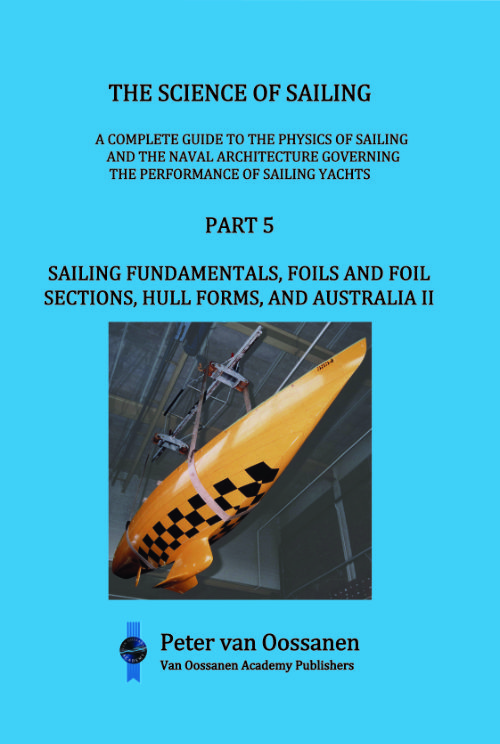Part 5 of “The Science of Sailing”, entitled “Sailing Fundamentals, Foils and Foil Sections, Hull Forms, and “Australia II” is available in print. It completes the series of books on sailing that I started to write in 2013. Several topics I originally wanted to cover remain untreated. In comparison with my original plan, the compendium of lift and drag data for sails, hulls, keels, and rudders is a case in point. I have collected such data throughout my naval architecture career, and I had planned to spend time bringing order to it for Part 6. Other topics that I had thought of needing to deal with are the detailed aspects of stability—transverse, longitudinal, and directional—as a result of having defined all the forces and moments and their location acting on a sailing craft, as described in Chapters 11 and 12 (Part 5).
Chapter 13 on foil sections is complete. I had from day one planned to include the results of regression analyses of all the NACA foil section data available, such as for the zero lift angle of attack, lift curve slope, lift coefficient and angle of attack at the end of the linear region, and maximum lift coefficient and angle of attack, and more. The results thereof will allow for the calculation of the lift curve for an arbitrary foil section. Chapter 14 covers the effects of finite span. The use thereof will allow for the assessment of the lift and drag of wings and foils, such as keels and rudders.
The properties of different hull forms, covered in Chapter 15, exclude a discussion of hulls with forward and aft overhangs such as those adopted for International Meter Class yachts. The chapter nevertheless provides information that will be useful to naval architects, including those involved in designing motor-driven craft.
Chapter 16 is now entirely dedicated to the “Australia II” project. I originally planned to add a description of other America’s Cup projects I was involved in, insofar as those projects yielded an innovation or another interesting development, but I simply needed to draw the line somewhere.
The material I wanted to cover concerning VPP modeling, CFD, and model testing has fallen by the wayside. I had originally planned to update my paper on that topic, entitled “Predicting the Speed of Sailing Yachts”, published in the transactions of the Society of Naval Architects and Marine Engineers, Vol. 101, 1993, for that purpose. The contents of that paper remain useful, however, so that its omission, unavoidable as it is, is not insurmountable. My 1993 paper on that topic can be downloaded at www.vanoossanenacademy.nl.
I want to thank the hundreds of people who have purchased Parts 1 through 4. Besides students and teachers of naval architecture and yacht design, the books have been ordered by sailors and others with an academic background from all over the world. Nearly two thousand copies have been sold to date—a number I wouldn’t have believed when I started this project.
